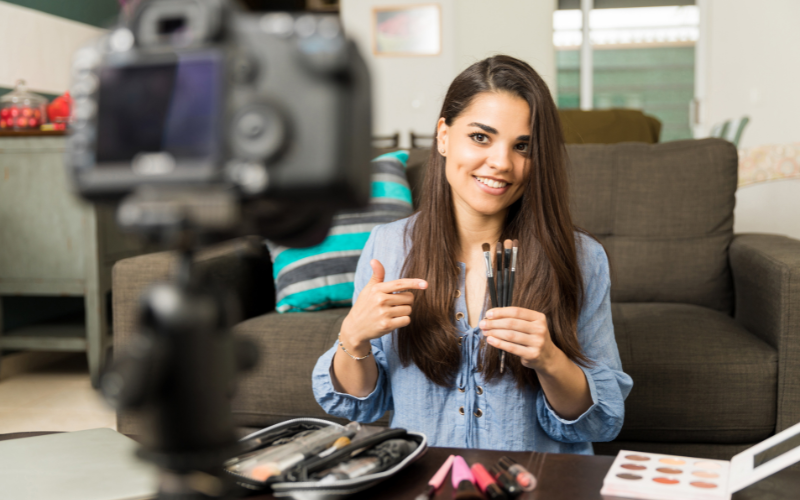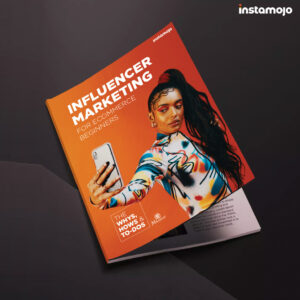Quick summary:
Navigating the world of influencer marketing? After all the money and time you spent on cultivating these partnerships, how do you know if it worked? We’re diving into the top KPIs of influencer marketing, from engagement rates to conversions. Let’s break down the essentials that digital-first brands like you should keep a close eye on to ensure their influencer collaborations pack a powerful punch and drive that ROI home.
What are the KPIs of influencer marketing?
Key Performance Indicators (KPIs) in influencer marketing are measurable metrics used to evaluate the success of a campaign.
These metrics can help you assess the impact of their collaboration with influencers and determine whether their goals have been achieved.
While there are various KPIs to choose from, selecting the right ones depends on the specific objectives of the influencer marketing campaign.
In case you missed it, check out our free webinar on the basics of Influencer Marketing with Drishti Sengupta, a Reputation Architect at Mavericks – a leading PR & Marketing Agency.
Let’s assume you follow the “G.L.O.W-Up” Strategy outlined by Drishti. Your campaign is live. The influencer has talked about products, shared your discount link etc.
Now?
Do you continue pumping money into the campaign without seeing if it’s gotten you your desired results?
You stop. Evaluate. And then fine-tune.
Here are some numbers that you should always be on the lookout for to track the success of your partnership.
13 Crucial KPIs of influencer marketing that you should track
Enhance your influencer marketing strategy by prioritizing crucial Key Performance Indicators (KPIs). From engagement metrics to conversion rates, mastering these indicators is pivotal for a successful and impactful influencer marketing campaign.
Let’s have a look at the top 13 KPIs of influencer marketing
Hold on! Before you check out these KPIs, grab this handy cheatsheet. It breaks down each metric, making it easy to understand and track.
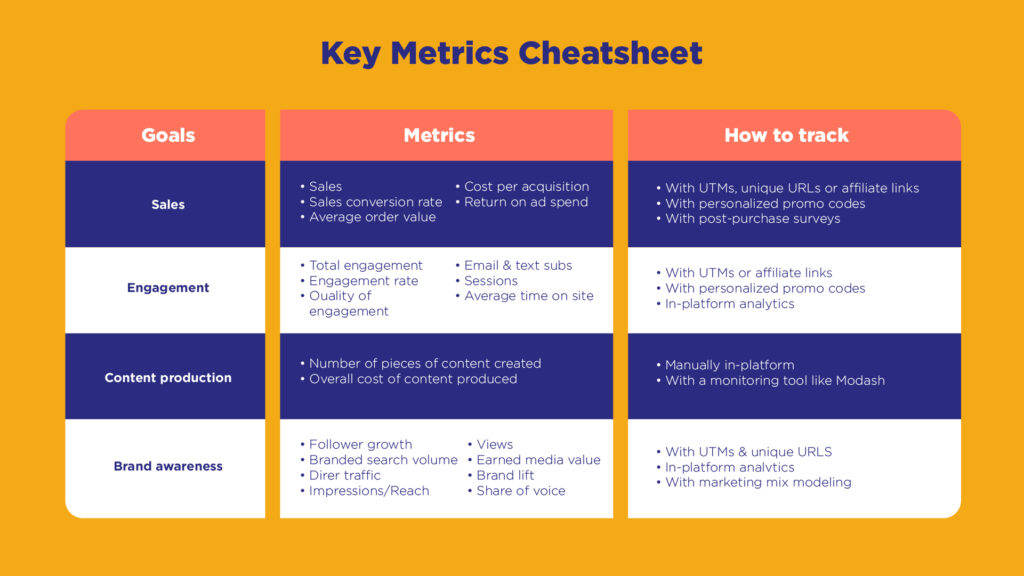
1. Brand awareness
Brand awareness measures the extent to which the target audience recognizes and recalls your brand. It indicates the effectiveness of influencer marketing in creating visibility.
Here’s what you have to look at when considering brand awareness of influencer marketing.
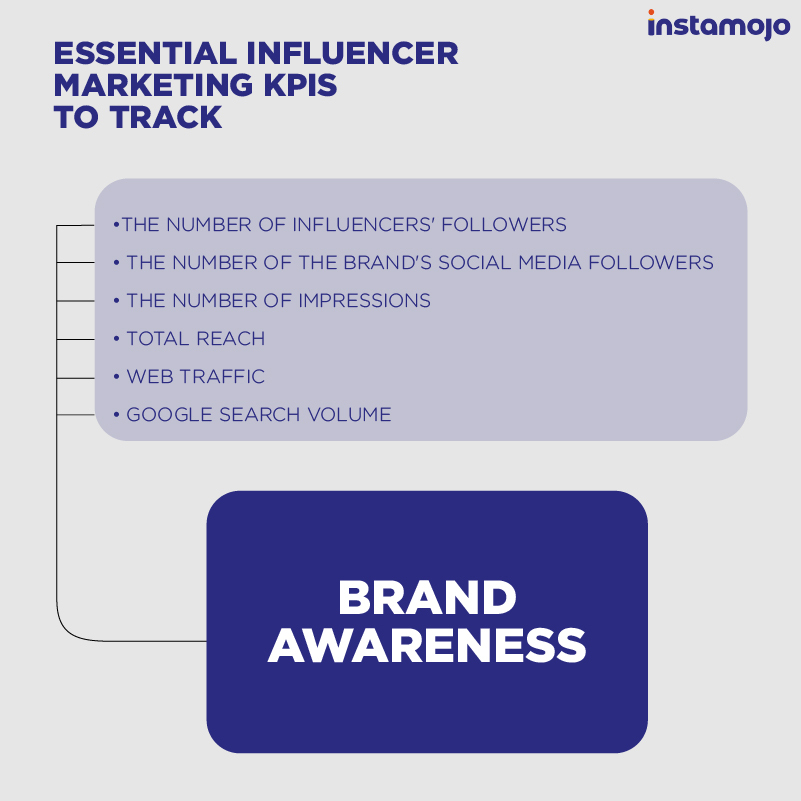
Formula: Tracked through surveys, social media mentions, or monitoring the increase in brand-related searches.
A rise in brand awareness suggests that the influencer’s content is successfully reaching and leaving an impression on the audience.
2. Engagement rate
Engagement rate measures the level of interaction your content receives relative to the number of followers. It includes likes, comments, and shares and clicks.
Explore key factors to consider when assessing the engagement rate KPI in influencer marketing.
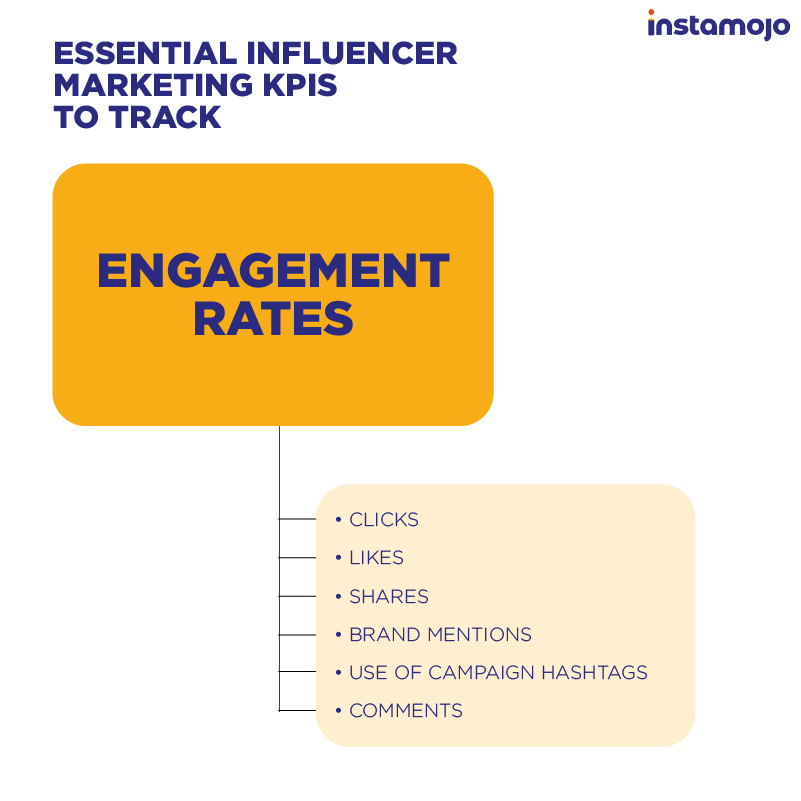
Formula: ER = {(Likes+Comments+Shares)}/Followers ×100
A higher engagement rate indicates that your influencer’s audience is actively participating and connecting with the content.
3. Referral traffic
Referral traffic quantifies the number of eCommerce website visits generated through the influencer’s content and links. It helps assess the impact of the influencer’s audience on your web traffic.
Let’s uncover crucial aspects to examine when evaluating the referral traffic KPI in influencer marketing.
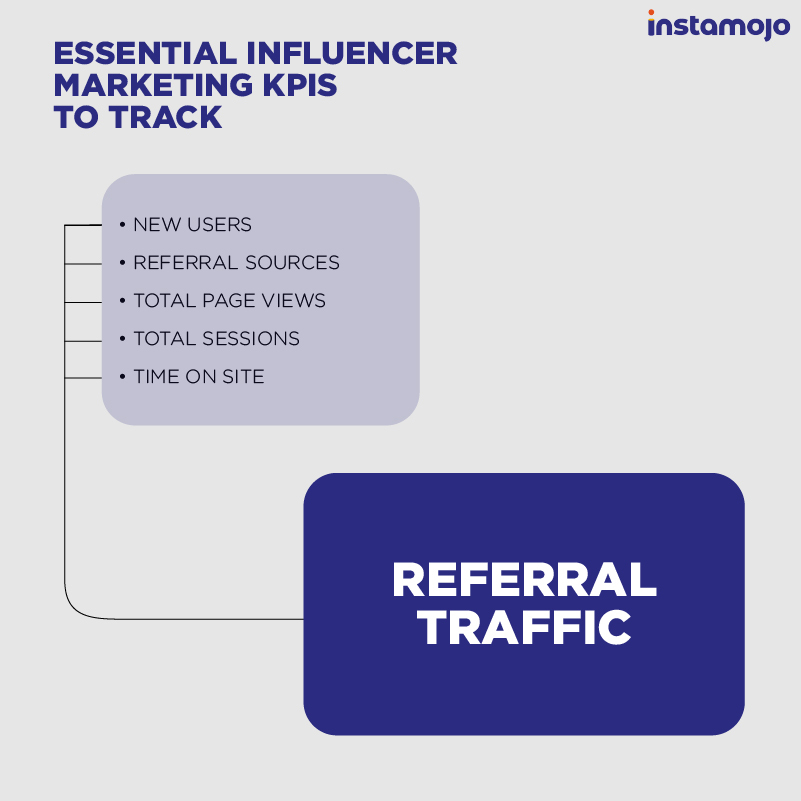
Formula: Tracked through website analytics tools.
A higher referral traffic indicates that the influencer’s audience is actively engaging with the provided links.
Moreover, here are more influencer marketing KPI’s to look at along with their metrics. Let’s have a look at them:

4. Reach
Reach represents the total number of unique users who see your influencer’s content. It provides an understanding of the potential audience exposure.
Formula: Reach = Follower + Impressions
The higher the reach, the more people will know about your brand, and will want to check out the products/services that your eCommerce website is offering.
5. Audience growth
Audience growth assesses the increase in the influencer’s followers over a specific period. It’s an essential metric for evaluating the expansion of your brand’s reach.
Formula: Audience Growth = (New followers – Lost followers / Total followers) × 100
A consistent positive audience growth demonstrates the influencer’s ability to attract and retain followers.
6. Audience demographics
Audience demographics provide insights into the characteristics of the influencer’s audience, such as age, gender, location, and interests.
Formula: Analyzed through social media analytics and audience insights tools.
Understanding the audience demographics helps tailor content to better resonate with the target market.
Related read: How to define and reach your target audience as an eCommerce business
7. Click-Through Rate (CTR)
CTR measures the percentage of people who clicked on a link in the influencer’s content, providing insights into the effectiveness of the call-to-action.
This link can be:
- A link to the product page on your online store
- A personalised discount link where a coupon code gets automatically applied during checkout
Formula: CTR = (Number of clicks/Number of Impressions) ×100
A higher CTR suggests that the influencer’s audience is interested in exploring more about the brand or product.
8. Conversion rate
Conversion rate measures the percentage of users who take a desired action, such as making a purchase or signing up, after interacting with the influencer’s content.
Formula: Conversion Rate = (Number of conversions/Number of clicks) ×100
A high conversion rate indicates that the influencer’s audience is not only engaged but also responsive to your call to action.
To correctly evaluate the conversion rate for your eCommerce business, make sure you have a website or online store for the audience to go to after interacting with the influencers’ content.
9. Return on Investment (ROI)
ROI measures the profitability of your influencer marketing campaigns by comparing the gained benefits to the costs incurred.
Formula: ROI = (Revenue – Cost/Cost) × 100
A positive ROI signifies a profitable campaign, while a negative ROI suggests that adjustments may be needed.
10. Brand sentiment
Brand sentiment evaluates the overall attitude and perception of the influencer’s audience towards your brand. It considers comments, mentions, and sentiment analysis.
Formula: Analyzed using sentiment analysis tools or manually by reviewing comments and mentions.
Positive sentiment indicates a favourable response, while negative sentiment may require adjustments to the influencer strategy.
11. Brand mentions
Brand mentions count the number of times your brand is mentioned across various platforms, indicating the level of online conversation about your brand.
Formula: Tracked through social media monitoring tools.
Increased brand mentions suggest heightened brand visibility and engagement.
12. Content quality
Content quality assesses the relevance, creativity, and overall impact of the influencer’s content. It provides insights into how well the content resonates with the audience.
Formula: Subjective evaluation based on feedback, comments, and performance metrics.
High-quality content contributes to positive audience perception and engagement.
13. Post frequency
Post frequency measures how often the influencer shares content related to your brand. It helps determine the optimal posting frequency for audience engagement and also helps you determine how your budget should change.
Formula: Post frequency = Number of brand – Related posts / Total number of posts × 100
Balanced post frequency ensures consistent visibility without overwhelming the audience.
Also, understand how you can start influencer marketing on a budget. Take a look:
View this post on Instagram
How to set up and run influencer marketing campaigns?
Influencer marketing has become a cornerstone of digital strategies, connecting brands with engaged audiences. So, let’s find out how to set up and run effective influencer marketing campaigns:
- Define clear goals: Outline specific campaign objectives for a solid strategy foundation, focusing on brand awareness, sales, or target demographics.
- Identify target audience: Understand your ideal audience’s demographics and interests to align with influencers who resonate with your brand.
- Choose influencers wisely: Select influencers based on values, audience size, engagement rate, and niche relevance.
- Craft engaging content: Collaborate for authentic, compelling content that resonates with influencers’ audiences and aligns with your brand message.
- Analyze key metrics: Regularly assess campaign performance against KPIs like engagement rate and reach to refine strategies for future success.
Love watching reels before buying? So, get ready to make a note of your favourite influencers and how they are performing in influencer marketing. Get every single detail of influencer marketing including types, cost of campaign plus case studies, we’ve prepared a FREE ebook that you can download here.
KPIs of influencer marketing: Track growth with Instamojo
If you are partnering with an influencer, you should be ready for a ton of attention!
But how long will you manage your customer requests on DMs?
Create your own online store with Instamojo. This will help you:
- Share coupon codes and discount links with influencers to promote
- Generate product links that the influencer can easily share
- Track website visits and sales from our Analytics dashboard
- Target abandoned carts with our automated emails
- Embed your or the influencer’s social media posts on your online store for maximum traction
So, it’s not just a choice; it’s the savvy way to ensure your brand stays relevant and connected in this fast-paced digital environment.
Build an online store with Instamojo for absolutely zero cost.

